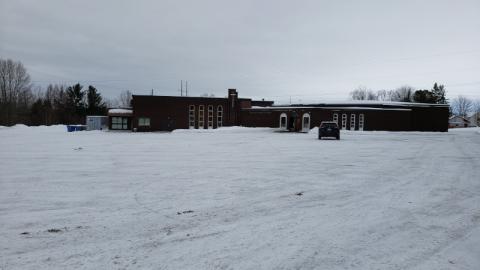
Day 3 of my journey back to Sudbury brought me to Saint Peter the Apostle parish, also in North Bay. Although this parish is not equipped for streaming the service, the pastor still made sure to offer mass even if only a maximum of 10 people could be present. This led to a moment of amusement: as I pulled up in the parking lot, parish greeters came to warn me that there was no more room. They quickly recognized me, though, and we had a good laugh about my presence: "I guess you can go in, Bishop!"
People kept arriving, as news of the effect of the lockdown on worship had not yet reached everyone. I was then asked, "Could people stay in the parking lot, doing the reading and saying the rosary, and then receive communion?" I was very moved by this request, so of course I said yes. In fact, I adjusted my whole homily around this new development. This idea of having people inside the church engaged in the sacrificial worship, while others pray outside in communion with that sacrifice, is actually a very old idea, dating back to Jewish times. We see it mentioned in the gospel of Luke, when Zechariah goes to offer incense while others are praying outside of the sanctuary. Their prayer was being done in union with what Zechariah, as a priest, was doing: despite the separation, the unity of intent made it one act of worship.
As the Jewish people spread throughout the world, they brought this tradition of prayer with them. Jews in Rome, for example, could not go to the Temple in Jerusalem to take part in the sacrifices, but nothing prevented them from being united in their hearts with those sacrifices regardless of distance. They diligently studied the Old Testament, and when the temple was destroyed in 70 A.D., they kept on praying at times that symbolically represented those times when sacrifices would have been scheduled. Prayer itself became the expression of the sacrifice.
The early Christians maintained this custom of scheduled prayer, known as the Divine Office or Liturgy of the Hours, and it became a core part of the spirituality of those in monastic life. For those unable to afford (or read) the prayer books it involved, an alternative developed: the Marian Rosary. Until recently it involved the recitation of 150 Hail Mary prayers, to match the number of Psalms (which formed the core of the Divine Office).
So think of it: a group of people in the parking lot, doing the readings and praying the Rosary: they were spontaneously copying a tradition that has very ancient origins. So we made sure everyone received communion, and after mass was over inside I made sure to make my way outside to offer a brief homily explaining all these elements, and then offering the solemn blessing for the New Year.
I love these moments when the work of the Holy Spirit becomes so visible!
- Anmelden, um Kommentare verfassen zu können
